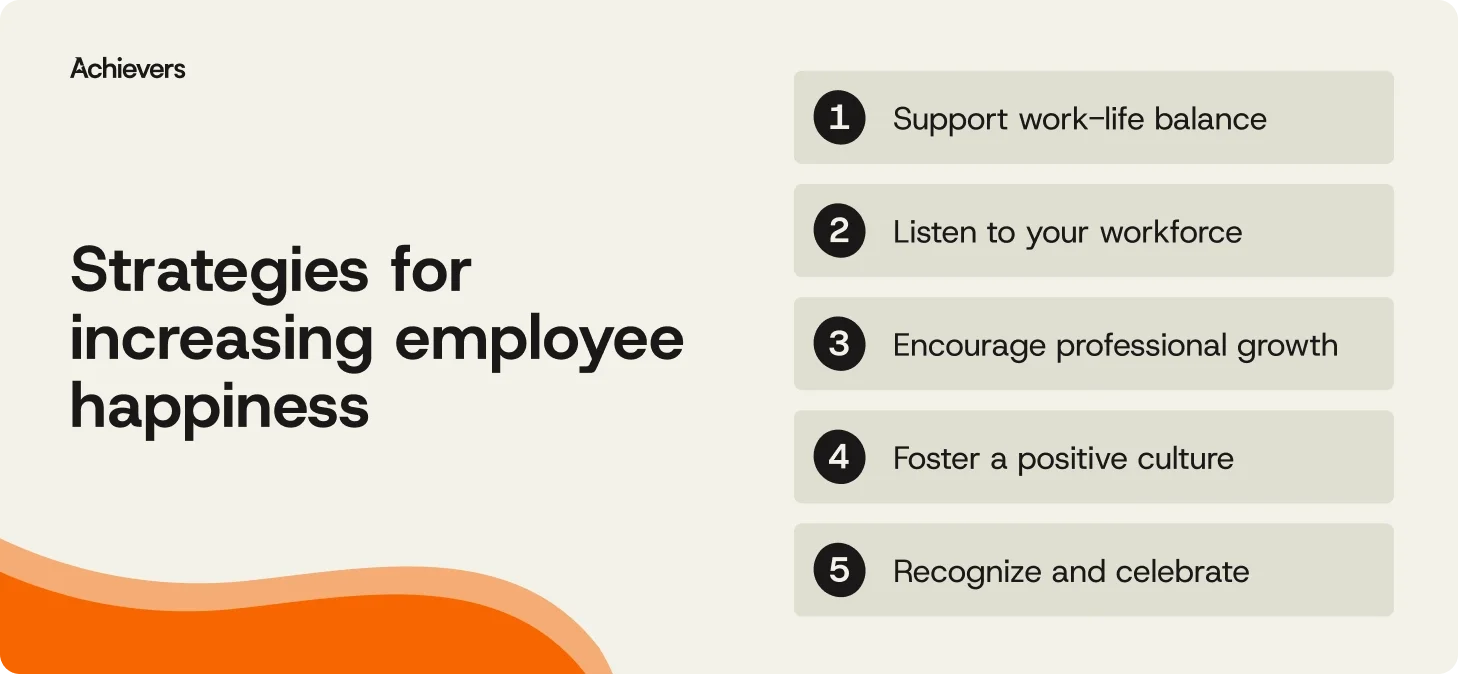Table of contents
Create a culture that means business™
Schedule a demo with an Achievers solution expert today.
Employee happiness isn’t something you can buy with a paycheck — not anymore, and honestly, maybe not ever. Sure, competitive compensation matters. But even the best-paid roles won’t hold onto top talent if the day-to-day experience leaves people feeling overlooked or undervalued. In fact, 72% of employees would rather work somewhere they feel valued, even if it means taking a lower salary, according to Achievers’ emotional salary data.
The real impact comes from recognition, work-life balance, and a voice in shaping how things get done. These are the kinds of investments that truly move the needle on employee happiness.
Ready to make it happen? Let’s dive into 13 people-first ways to help boost employee happiness across your organization.
13 strategies for increasing employee happiness
Employee happiness is the difference between a team that’s coasting and one that’s genuinely invested. And the good news? It’s not rocket science. With the right habits, policies, and mindset shifts, any company can create a workplace where people feel energized to show up and do their best work.
Here are 13 ways to make that happen:

1. Support work-life balance
No one does their best work running on fumes. If employees can’t find time to rest, recharge, and not think about work, burnout is just around the corner — no matter how “engaged” they seem today.
Start with the basics: PTO that people actually take, breaks that don’t come with a side of guilt, and managers who know better than to ping someone mid-vacation. From there, build a culture that respects boundaries and champions well-being. Not just in policy, but in practice.
2. Listen to your workforce
If you want employees to feel like they matter, start by proving you’re listening. Not nodding-along-in-meetings listening — real, meaningful, “we heard you and here’s what we’re doing about it” listening.
Give people channels to speak up (surveys, forums, Slack threads — take your pick), then follow through. When feedback leads to action, employees stop feeling like passengers and start feeling like co-pilots.
3. Encourage professional growth
Few things kill motivation faster than feeling stuck. If your employees can’t see a path forward — or worse, don’t believe one exists — they’ll start looking for a new one elsewhere.
Career development shouldn’t be a mystery or a side hustle. Be clear about growth opportunities, provide the tools to get there, and show employees you’re just as invested in their future as they are.
4. Foster a positive work culture
Workplace culture isn’t about free snacks or quirky Slack emojis. It’s how people feel day to day — whether they’re supported, trusted, included, and recognized.
A strong culture runs on clarity, communication, and a shared sense of purpose. It welcomes different perspectives. It celebrates wins (big and small). And when it works, it makes people want to stay — and do their best work while they’re at it.
5. Recognize and celebrate contributions
Want a shortcut to boosting happiness? Say thank you — and mean it. Regular, meaningful recognition reminds employees that their work matters and that their effort isn’t going unnoticed.
It doesn’t have to be a confetti cannon moment every time. A timely shoutout, a peer-nominated award, or a note that says, “You made a real impact here,” goes a long way. Recognition fuels motivation, strengthens culture, and helps employees feel seen, not just managed.
6. Prioritize psychological safety
People can’t be happy at work if they’re afraid to speak up. Psychological safety means employees feel comfortable being honest — sharing ideas, giving feedback, even admitting mistakes — without fear of blame or backlash.
It starts at the top. Leaders who model vulnerability and curiosity set the tone for open dialogue. Build that trust, and you’ll get better collaboration, stronger problem-solving, and, yes, happier employees.
7. Offer flexibility (and mean it)
Flexibility isn’t a perk — it’s an expectation. Whether it’s hybrid schedules, remote work, or adjustable hours, people want to be trusted to do great work in the way that works for them.
Flexibility shows respect for employees’ lives outside the office. And when done right, it doesn’t just make people happier — it makes them more productive. Win-win.
8. Create opportunities for connection
When employees feel isolated, happiness tanks. Connection — to teammates, to leaders, to the broader mission — is a powerful buffer against disengagement.
Make space for it. Think beyond happy hours and look at mentorship programs, cross-functional projects, and digital recognition walls that give people a reason to interact and celebrate one another.
9. Embrace transparency
Nobody likes being left in the dark. Clear communication about what’s happening and why — whether it’s about company goals, strategy shifts, or performance expectations — builds trust and reduces anxiety.
Transparency doesn’t mean oversharing every spreadsheet. It means treating employees like the smart, invested adults they are. Do that, and you’ll see stronger alignment and a boost in morale.
10. Make inclusion a daily practice
Belonging isn’t something you check off with a one-time DEI workshop. It’s built through everyday behaviors — how meetings are run, how feedback is shared, how recognition is given.
Employees are happiest when they feel accepted, respected, and safe to be themselves. From inclusive language to equitable recognition practices, small shifts can create big ripple effects.
11. Align work with purpose
Most people want more than a paycheck. They want to know their work has meaning. That their efforts contribute to something bigger.
Help connect the dots. Share how individual contributions ladder up to company goals. Celebrate behaviors that align with your values. When people see how their work fits into the bigger picture, it makes the day-to-day feel more fulfilling — and a whole lot more worth it.
12. Build recognition into the day-to-day
If recognition only shows up in annual reviews or monthly shoutouts, you’re missing the moments that matter most. Real happiness comes from being appreciated in the moment, not weeks later.
Make recognition a daily habit. Train managers to give specific, timely praise. Empower peers to recognize each other through tools that make it easy, whether that’s a dedicated platform, a Slack integration, or a public feed. Celebrate wins tied to your company values so employees see the connection between their actions and the bigger picture.
13. Use real-time insights to shape what’s next
You can’t improve what you don’t measure. Relying on gut feel or outdated engagement surveys won’t cut it, especially if you want to build a culture that truly supports employee happiness.
Start tracking what matters. Use recognition data to see which teams are thriving (and which might need support). Monitor feedback trends and respond quickly. And share insights with managers so they’re equipped to lead with empathy and strategy. When decisions are backed by real-time data, everyone benefits (especially your employees).
How recognition fuels employee happiness
You can’t fake employee happiness. People know when they’re appreciated — and they definitely know when they’re not. Recognition is how you make that appreciation visible, consistent, and meaningful.
And when it is, everything starts to shift. Engagement deepens. Performance improves. People stop coasting and start contributing at full force. Recognition isn’t a side program — it’s the pulse of a thriving culture.
Here’s what the data from our ROI report shows:
- Employees who receive meaningful recognition at least monthly are more engaged, loyal, and productive than those recognized quarterly or less
- Organizations with an online recognition platform are 2x more likely to say their program drives business results
- Strategic recognition tied to values and goals is far more effective than generic praise — it’s the key to reinforcing the behaviors that move your company forward
The takeaway? If you want employee happiness to last — and positively impact the business — start by making recognition a habit, not an afterthought.
Make employee happiness part of your everyday culture
You can throw a dozen initiatives at employee happiness — or you can make it part of how your organization runs. That means connecting the dots between recognition, feedback, celebration, and culture in one place, where it really sticks.
Achievers makes it easy. From empowering employees to give and receive recognition in the moment, to capturing real-time feedback and celebrating meaningful milestones, our recognition and rewards platform helps you build a culture where people feel seen, supported, and motivated to give their best.
Looking to build a happier, more engaged workforce? We’ll help you get there.



